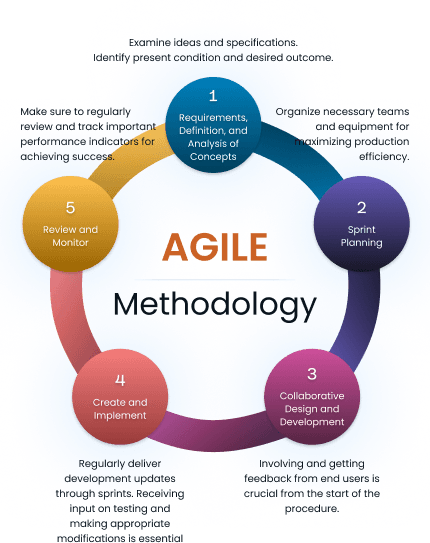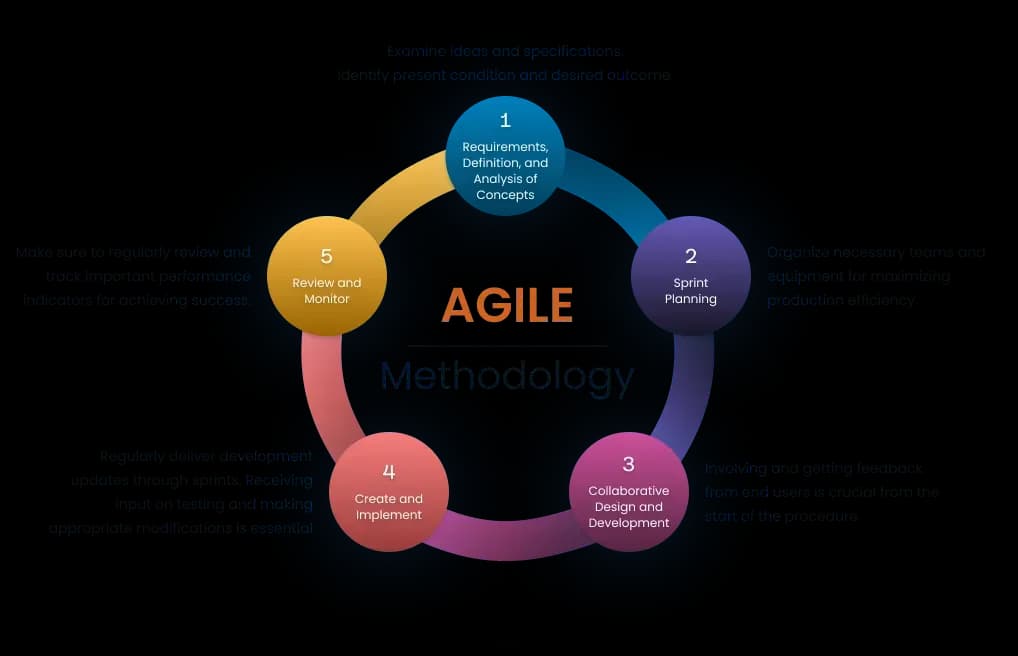Agile Methodology
Agile software development refers to a set of methods and practices based on the values and principles expressed in the Agile Manifesto. Agile works on an iterative development methodology, where requirements and solutions evolve through collaboration between self-organizing cross-functional teams.



Core Values of Agile
Individuals & Interactions Over Processes & Tools
Valuing people more highly than processes or tools.
Working Software Over Comprehensive Documentation
Delivering functional software frequently, with a preference to the shorter timescale.
Customer Collaboration Over Contract Negotiation
Collaborating with customers for requirements.
Responding to Change Over Following a Plan
Being flexible and responsive to changing requirements and environments.
Key Principles of Agile
Agile Methodologies
Scrum
A framework that allows teams to work on complex projects and deliver high-value products by approaching problems adaptively.
Kanban
A visual method for managing the creation of products with an emphasis on continual delivery without overburdening the development team.
Extreme Programming (XP)
Aims to improve software quality and responsiveness to changing customer requirements with frequent releases in short development cycles.
Lean Software Development
Based on the principle of lean manufacturing, it optimizes efficiency and minimizes waste in the production of software.
Agile Practices
Daily Stand-Ups
Short daily meetings to update the team on progress.
Sprints
Time-boxed periods where a certain amount of work has to be completed.
Pair Programming
Two programmers work together at one workstation.
Test-Driven Development (TDD)
Writing tests before writing the code to fulfill those tests.
Continuous Integration (CI)
Merging all developer working copies to a shared mainline several times a day.
Sprints in Agile Software Development
Sprints are a fundamental component of Agile methodologies, particularly in Scrum. They are time-boxed periods, usually ranging from one to four weeks, during which a specific set of tasks or a piece of work is completed and made ready for review.
Key Aspects of Sprints
Sprint Planning
Before a sprint begins, the team holds a sprint planning meeting to decide what work will be accomplished during the sprint.
Set Duration
Each sprint is of a fixed duration and ends on a specific date, whether or not the work has been completed.
Sprint Goals
The team identifies a small, manageable set of goals to be achieved by the end of the sprint.
Daily Standups
Daily meetings, often called "stand-ups," help the team to stay on track with the sprint's goals.
Sprint Review
At the end of the sprint, the team demonstrates what they've built. Stakeholders give feedback to ensure the product is aligning with their needs.
Sprint Retrospective
After the review, the team discusses what went well, what didn’t, and how processes could be improved.
Purpose of Sprints
Focus and Clarity
Sprints provide a clear focus on specific goals within a set timeframe, helping teams to concentrate their efforts.
Regular Product Increments
They ensure regular updates to the product, often leading to quicker feedback from users or stakeholders.
Risk Management
Short sprints allow teams to adapt to changes more swiftly, reducing the overall risk of the project.
Continuous Improvement
Regular retrospectives promote continuous improvement in processes and products.
Customer Engagement in Agile Software Development
Agile methodologies emphasize close collaboration between the development team and the customer. Understanding what to expect and how to participate can greatly enhance the process and outcome.
What Customers Can Expect
Customer Participation
Ensuring the Best Experience
By actively participating and collaborating with the Agile team, customers can ensure a more tailored product and a successful project outcome.
Company Facts
& Figures
Our Office




